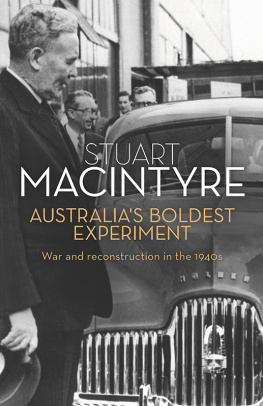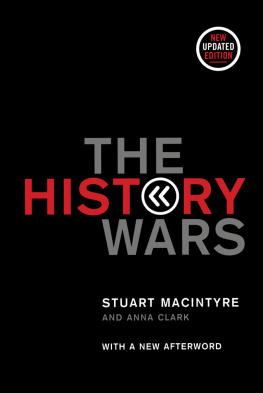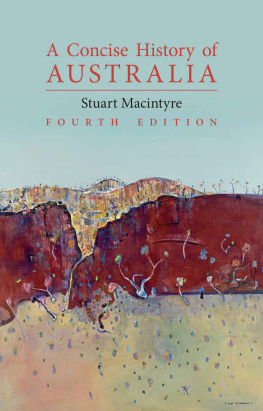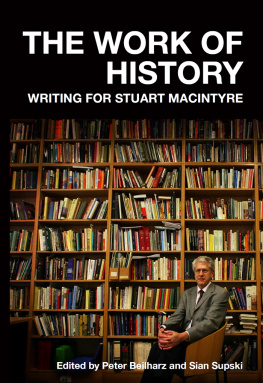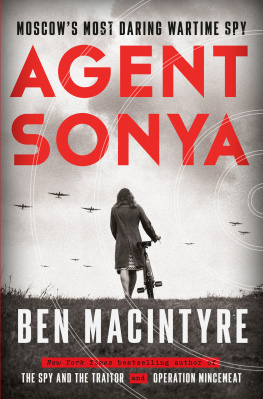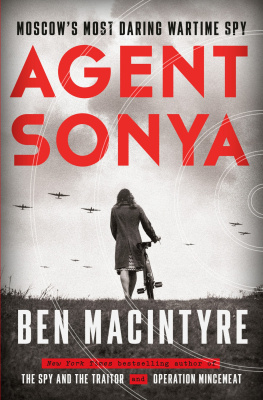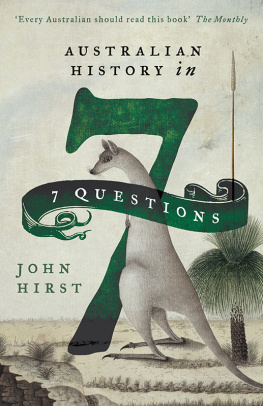AUSTRALIAS BOLDEST EXPERIMENT
STUART FORBES MACINTYRE AO is a former Ernest Scott Professor of History and Dean of the Faculty of Arts at the University of Melbourne. He has been voted one of Australias most influential public intellectuals. He is the author of the bestselling Concise History of Australia, which has gone into a number of editions, and editor, with Alison Bashford, of the two-volume Cambridge History of Australia. His book The Reds won The Age Non-Fiction Book of the Year Award in 1998 and The History Wars, co-written with Anna Clark won the 2004 New South Wales Premiers Australian History Prize.
STUART
MACINTYRE
AUSTRALIAS BOLDEST EXPERIMENT
War and reconstruction in the 1940s

A NewSouth book
Published by
NewSouth Publishing
University of New South Wales Press Ltd
University of New South Wales
Sydney NSW 2052
AUSTRALIA
newsouthpublishing.com
Stuart Macintyre 2015
First published 2015
This book is copyright. Apart from any fair dealing for the purpose of private study, research, criticism or review, as permitted under the Copyright Act, no part of this book may be reproduced by any process without written permission. Inquiries should be addressed to the publisher.
National Library of Australia Cataloguing-in-Publication entry
Creator: Macintyre, Stuart, 1947 author.
Title: Australias boldest experiment: war and reconstruction in the 1940s/Stuart Macintyre.
ISBN: 9781742231129 (paperback)
9781742247250 (ePDF)
9781742241975 (ePub/Kindle)
Subjects: Reconstruction (1939-1951) Australia.
Australia Economic conditions 1939 1945.
Australia Economic conditions 1945
Australia Economic policy 1939 1945.
Australia Economic policy 1945
Australia Social conditions 1939 1945.
Australia Social conditions 1945
Dewey Number: 994.05

Design Josephine Pajor-Markus
Cover design Xou Creative
Cover images Chifley with the first Holden, Fishermans Bend, 1948 (Fairfax Syndication)
All reasonable efforts were taken to obtain permission to use copyright material reproduced in this book, but in some cases copyright could not be traced. The author welcomes information in this regard.
CONTENTS
ACKNOWLEDGMENTS
I t used to be said that nothing ever happened in Australian history, but no longer every schoolchild knows, or at least is taught, that Australians went to war. The taking up of arms has become a dominant theme of the nations past, giving rise to its most cherished traditions. Commemoration of past wars, public ceremonies and personal pilgrimages are served by a seemingly unending stream of publications that celebrate martial valour, making it seem that it is only when under fire that Australians can come together in common purpose. This book proceeds from a different conviction. It is concerned with war as a catalyst for change, a time of stress that disrupts existing arrangements, an ordeal that imposes heavy demands and an endeavour that creates new expectations.
While it is often claimed that the First World War consummated Australian nationhood, the Second World War reached more deeply into the fabric of society and brought a more substantial reconstruction. This book is concerned with the aims and outcomes of what I believe to have been Australias boldest experiment. Some of the changes it brought are familiar the influx of migrants, the epic engineering works in the Snowy Mountains, the Holden car and others have received attention in historical research, but their place within the larger plan to reconstruct this country has been largely forgotten.
In writing its history I have drawn on the work of many scholars. I have also been assisted by information, advice and encouragement from Peter Bailey, Weston Bate, Peter Beilharz, Anne Bickford, Geoffrey Bolton, Carl Bridge, Philip Buckner, Kate Darian-Smith, Graeme Davison, Phillip Deery, Warwick Eather, Carol Fort, Robert Freestone, Hector Gallagher, David Goodman, Murray Goot, Bridget Griffen-Foley, Roy Hay, Jenny Hocking, Carolyn Holbrook, Joe Isaac, Evan Jones, Sir Peter Lawler, David Lowe, Jim McAloon, Daryl McIntyre, Laurence Maher, Susan Marsden, Ian Mence, David Merrett, Alex Millmow, Dan Morrow, Seamus OHanlon, Greg Pemberton, Joyce Peters, Shirley Pitcher, Len Richardson, Tim Rowse, Sean Scalmer, Geoffery Sherington, Peter Stanley, Paul Strangio, Shurlee Swain, Jim Tomlinson, Patrick Troy, Simon Ville, David Vines, James Walter and Chris Waters. Staff at the National Archives of Australia, the National Library of Australia, the Noel Butlin Archives Centre at the Australian National University, the Archives at the University of Melbourne and those at Flinders University, Monash University and the South Australian Housing Trust were invariably helpful. Sarah Midford and Andr Brett contributed to the research. The project was made possible by a Discovery Project grant from the Australian Research Council and its publication was assisted by a Publication Subsidy grant from the Arts Faculty of the University of Melbourne. Frank Bongiorno, Nicholas Brown and John Hirst read the manuscript and made invaluable suggestions. I am grateful to Averil Moffat for her work as editor, and to Phillipa McGuinness and her colleagues at NewSouth Publishing for their support.
My greatest debt is to Graeme Powell. Formerly the head of special collections at the National Library of Australia, Graeme has an unparalleled knowledge of the manuscript sources of Australian history, which he has shared with many researchers. He first compiled detailed digests of published and unpublished sources, then turned to the official records in the National Archives. The volume of files generated by reconstruction is immense and many have not previously been used. Graemes exploration of this resource led to his preparation of a detailed and annotated reference work, Post-War Reconstruction in Australia 194150: A Guide to the Records, now published by the National Archives. In addition, Graeme undertook closer investigation of particular topics and helped track down illustrations. I could not have written the book without him, and benefitted enormously from his close familiarity with Canberra and its ways.
Finally, I dedicate this book to my wife Martha. There was dancing on the streets when she was born for it was the day the war ended. After her family spent the early post-war years in a boarding house, they moved into one of the new public housing estates in the western suburbs of Melbourne and she began school with children from all parts of Europe who passed through the nearby immigration centre. Her parents, active in the local branch of the Labor Party, were among the many Australians who mourned the death of Ben Chifley in 1951. The light that he lit shone brightly on Martha and her generation.
ABBREVIATIONS
| ABC | Australian Broadcasting Commission |
| ACTU | Australian Council of Trade Unions |
| AIF | Australian Imperial Force |
| ALP | Australian Labor Party |
| BHP | Broken Hill Proprietary |
| BMA | British Medical Association |
| CRTS | Commonwealth Reconstruction Training Scheme |
| CSIR | Council for Scientific and Industrial Research |
| CSIRO | Commonwealth Scientific and Research Organisation |
Next page
